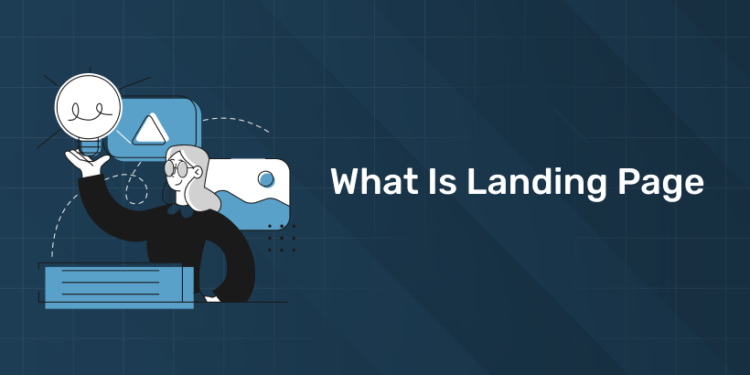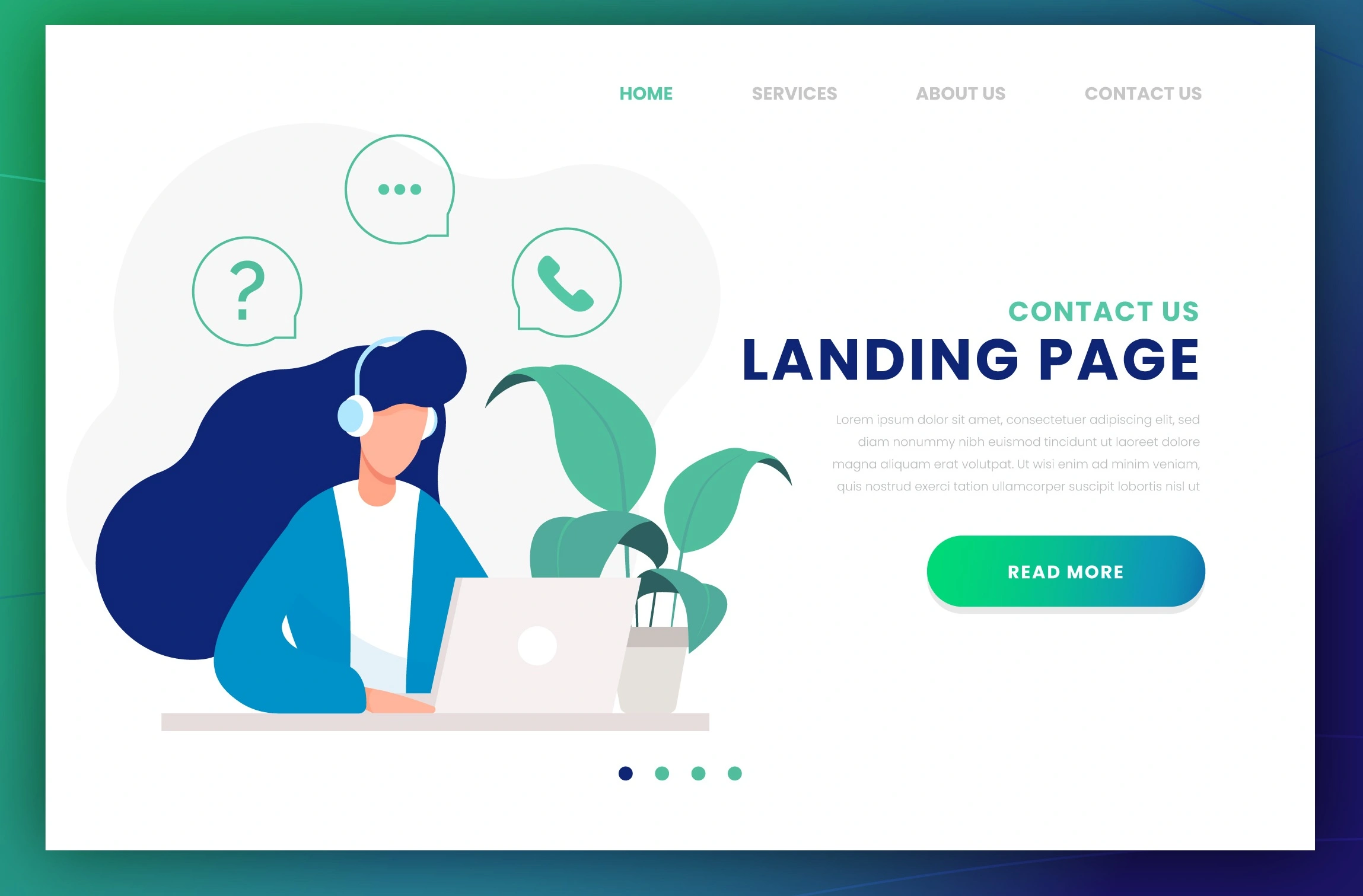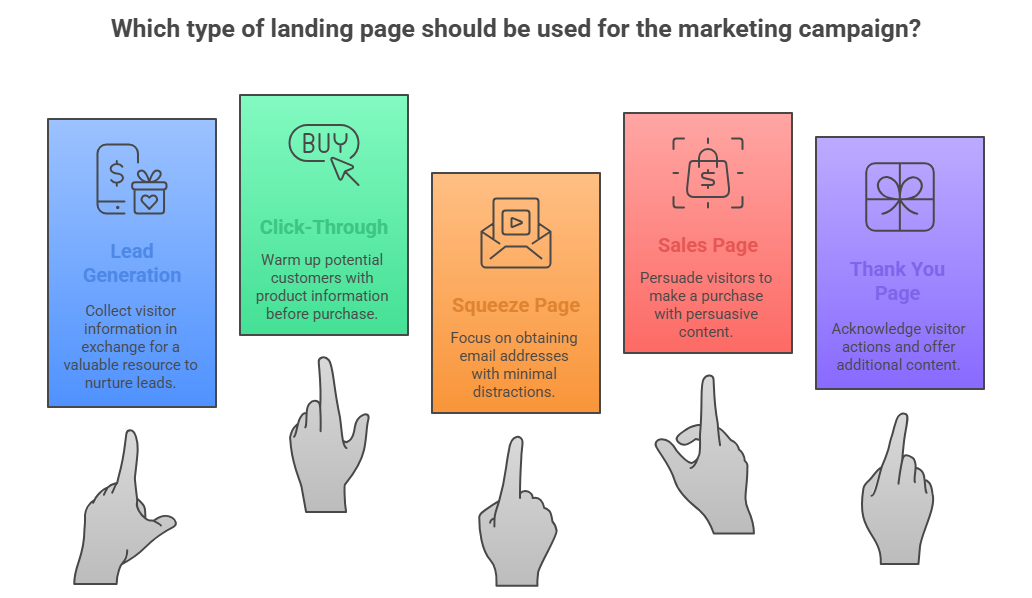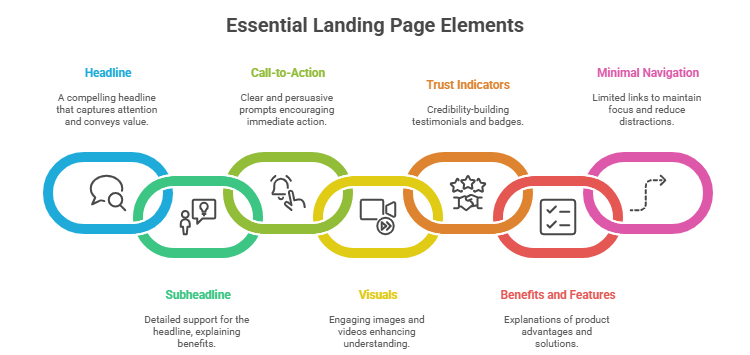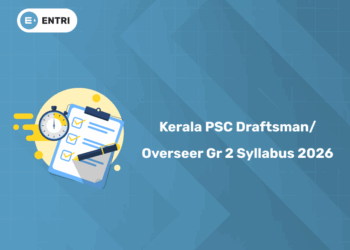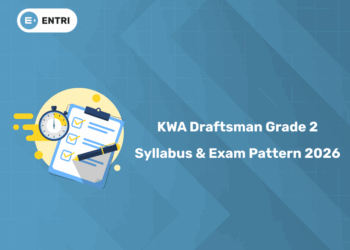Table of Contents
In the fast-paced world of online marketing, landing pages are among the most effective ways to increase conversions, capture leads, and boost sales. Whether you’re running a paid ad campaign, email marketing, or social media ad, a landing page can be the difference between converting a visitor and losing them to the competition.
For digital marketers, landing pages, what they’re for, and how to optimize them, are key to getting the biggest return on your investment. In this blog, we’ll discuss what a landing page is, why it matters, types of landing pages, and best practices for high-converting pages can help you master landing page optimization.
Join Our Online Digital Marketing Course & Learn the Fundamentals!
What is a Landing Page?
Landing pages are single web pages whose sole purpose is to convert visitors to push them toward one clear call-to-action. Unlike a website homepage, which has many objectives, a landing page has one objective, for example,
- Building email lists for lead gen
- Generating sales for a product or service
- Driving an eBook or resource downloads
- Between driving webinar signups or event registrations.
What makes a landing page different from other pages on your website is its goal – the goal of a landing page is to convert visitors into leads or customers by directing their attention to where you want it, without distraction from other content or navigation menus.
Types of Landing Pages and Their Uses
1: What is the primary goal of SEO (Search Engine Optimization)?
Landing pages can be very different depending on the marketing campaign. Here are the main types and their uses:
1. Lead Generation Landing Pages
These pages are designed to collect information from visitors, such as their names, email addresses and other relevant data. Lead generation pages usually offer something in return, like a free guide, webinar or discount code. The goal is to collect leads that can be nurtured and turned into customers.
2. Click-Through Landing Pages
Click-through landing pages are used to warm up potential customers before sending them to a purchase. These pages provide information about a product or service so users can understand what it’s about. Once convinced, visitors click through to a product or pricing page to buy.
3. Squeeze Pages
A squeeze page is a type of lead generation landing page that focuses on getting a visitor’s email address. These pages have minimal distractions and aim to “squeeze” information out of the visitor in exchange for a valuable resource, like a cheat sheet, checklist or discount offer.
4. Sales Pages
Sales pages are designed to sell to visitors. These pages have persuasive content, testimonials and other elements to build trust and show value so visitors can move through the buyer journey.
5. Thank You Pages
Not a traditional landing page, thank you pages appear after a visitor has taken an action (e.g. signed up or bought). They acknowledge the action taken and can offer additional content like related articles, videos or downloadable resources.
Become an AI-powered Digital Marketing Expert
Master AI-Driven Digital Marketing: Learn Core Skills and Tools to Lead the Industry!
Explore CourseLanding Page Essentials
For a landing page to work, it needs to have these elements that convert:
1. Headline
A killer headline is key. It should immediately tell the value of the page and make visitors want to stay and read more. A good headline sets the tone for the page and explains what visitors can expect.
2. Subheadline
The subheadline supports the headline by adding more detail to the offering. It explains the benefits or purpose of the page in more detail.
3. Call-to-Action (CTA)
The CTA is the most important part of a landing page. Whether it’s a button that says “Download Now,” “Get Started,” or “Sign Up,” the CTA should be clear, persuasive, and in the right place to encourage action.
4. Visuals
Images, videos or graphics can make a landing page more interesting and visually appealing. Visuals can help visitors understand the offer and its benefits. For example, a product demo video can show the product in action and make it easier for users to decide.
5. Trust Indicators
Trust indicators such as customer testimonials, user reviews and trust badges help build credibility. These elements tell visitors that your product or service has been used by others and can be trusted.
6. Benefits and Features
Explain the benefits of your product or service. Visitors should understand what you offer but also how it will help them solve a specific problem or meet a need.
7. Minimal Navigation
To keep visitors focused, it’s best to limit navigation links on landing pages. This reduces distractions and keeps users on the main objective of the page.
Why Use Landing Pages in Your Marketing
Landing pages are a key part of digital marketing. Here’s how they can help:
- Increase Conversion Rates: Landing pages are designed to direct visitors to a specific action, which can lead to higher conversion rates than general website pages.
- Get Leads: Through forms and CTAs, landing pages can capture valuable information about visitors and help you build a list of leads.
- Improve Ad Campaigns: Pair landing pages with PPC or social media ads, and visitors see relevant information to the ad they clicked, which increases the chances of conversion.
- Measurable Outcomes: With landing pages you can track (e.g. bounce rate, time on page, conversions) to measure your marketing campaigns.
- Boost SEO: Optimize landing pages for specific keywords and have a strong user experience and you’ll boost your website’s SEO and get organic traffic.
How to Build a Landing Page That Converts (Step by Step)
Building a landing page that converts takes planning and execution. Here’s a step-by-step:
Step 1: What’s the Goal
What do you want visitors to do on your landing page? Whether it’s getting leads, making sales, or promoting a webinar, define your goal first.
Step 2: Who’s Your Audience
Identifying your target audience is important to build the landing page.
Step 3: Headline
Write a headline that grabs attention and tells the value of your offer.
Step 4: Copy
Focus on benefits that solve your audience’s pain points or desires. Copy should be clear, concise and persuasive.
Step 5: Visuals
Use high quality images or videos that support your message and give visitors a better understanding of your product or service.
Step 6: Call-to-Action
Make sure your CTA button is clear, actionable and stands out on the page. Use language that tells visitors to take action (e.g. “Get Started Now”)
Step 7: Trust Elements
Add testimonials, trust badges or case studies to build credibility and reassure visitors you’re trustworthy.
Step 8: Mobile Friendly
Make sure your landing page is mobile optimised as many users access websites through mobile.
Step 9: Test and Refine
Use A/B testing to try different headlines, images, CTAs and other elements to see what works.
Don’t Do This When Building a Landing Page
- Cluttered Design: Too much info or visuals can overwhelm. Keep it simple and focused.
- Weak CTA: A vague or passive CTA won’t convert. Make it clear and compelling.
- Too Many Links: Multiple links and options can confuse users. Limit options to keep them focused on your goal.
- No Mobile Optimisation: Many users access websites on their mobile, so a mobile-friendly landing page is a must.
- No Testing and Analytics: Skipping A/B testing and data analysis means missing out on opportunities to improve.
Become an AI-powered Digital Marketing Expert
Master AI-Driven Digital Marketing: Learn Core Skills and Tools to Lead the Industry!
Explore CourseHow Landing Pages Affect SEO
Landing pages, when optimised, can have a positive impact on SEO. Here’s how:
- Keyword Optimisation: By targeting specific keywords, landing pages can rank for relevant search queries and get organic traffic.
- Better User Experience: A well-designed landing page improves user experience, lowers bounce rate,s and longer time on page all of which are good for SEO.
- More Relevant Content: When landing pages have content that matches user search intent, they are more likely to be seen as relevant by search engines.
- More Backlinks
Master Landing Page Optimization with Entri’s AI-powered Marketing Course
To be a digital marketer, understanding landing pages is just one piece of the puzzle. Entri’s AI-powered Marketing Course teaches marketers how to design, optimize, and analyze landing pages. The course covers:
- Landing page creation for lead gen, sales, and events
- A/B testing and conversion optimization techniques
- Mobile-first landing page design
- AI-driven insights for personalization and targeting
By joining Entri’s course, marketers can learn how to create high-converting landing pages and improve overall campaign performance.
Key Takeaways for Marketers
- Landing Pages are Conversion-Focused: Unlike regular website pages, landing pages are designed to drive leads or sales.
- Clarity and Focus are Key: Remove distractions and one CTA to get the best results.
- Visuals, Social Proof, and Copy Matter: High-quality images, testimonials, and copy increase trust and conversions.
- Mobile is Non-Negotiable: With mobile-first indexing and growing mobile traffic, responsive landing pages are a must.
- Continuous Testing is Key: A/B testing and data-driven optimization help to improve over time.
Conclusion
Landing pages are a crucial part of digital marketing campaigns, providing a focused, conversion-driven experience for users. From lead gen and sales pages to webinar registrations, landing pages help businesses grab attention, build trust, and get measurable results.
For marketers looking to upskill, Entri’s AI-powered Marketing Course offers hands-on training in landing page optimization and other advanced marketing strategies, so you can stay ahead in the digital landscape. By using landing pages, you can increase engagement, conversions, and your marketing ROI.
Frequently Asked Questions
What is a landing page, and how does it differ from a regular webpage?
A landing page is a standalone webpage specifically designed to capture visitor attention and encourage a specific action, like signing up or making a purchase. Unlike regular webpages, which may include multiple links and navigation options, landing pages are focused on one clear objective. They typically have minimal distractions and direct visitors toward a single call-to-action (CTA), such as filling out a form or clicking a “Get Started” button.
What are the main types of landing pages, and what purposes do they serve?
Landing pages come in several types, each with a specific purpose. Lead generation pages collect visitor information in exchange for something valuable, like an eBook or discount. Click-through pages provide detailed information to “warm up” visitors before leading them to a sales page. Squeeze pages focus on gathering email addresses quickly, while sales pages encourage immediate purchases. Thank you pages appear after an action, like signing up, and provide confirmation and additional offers.
What are the essential elements of a high-converting landing page?
A high-converting landing page includes several key elements: a strong, attention-grabbing headline, a clear subheadline, and a compelling call-to-action (CTA) button. Visuals, such as images or videos, make the page more engaging, while trust indicators like testimonials and badges build credibility. A concise explanation of the product’s benefits or features, along with minimal navigation, ensures visitors remain focused on the desired action.
Why are landing pages important in a digital marketing strategy?
Landing pages play a vital role in digital marketing because they are designed to increase conversions. They capture visitor information for lead generation, drive sales, and enhance the effectiveness of PPC, social media, and email campaigns. Landing pages also allow marketers to focus on specific goals and provide clear, measurable results. This focused approach can lead to higher conversion rates and more effective use of marketing resources.
How can I create a landing page that converts well?
To create a high-converting landing page, start by defining your goal (e.g., lead generation or sales). Next, craft a compelling headline that speaks to your audience’s needs, followed by engaging copy that highlights benefits. Include a strong CTA that stands out, and add visuals or a video that support your message. Use trust elements like testimonials or guarantees to build credibility. Finally, test different elements through A/B testing to see what performs best.
What are common mistakes to avoid when creating landing pages?
Common mistakes include cluttered design, which can overwhelm visitors; a weak or unclear CTA; and too many links or options that distract from the main objective. Failing to optimize for mobile can result in a poor experience for smartphone users, and neglecting A/B testing can prevent you from optimizing the page for better conversions. Overloading the page with information can also dilute your message and reduce engagement.
How do landing pages contribute to SEO, and can they help improve search rankings?
Landing pages can benefit SEO when optimized for relevant keywords, enhancing their ability to rank for specific search queries. A well-optimized landing page provides a strong user experience, lowers bounce rates, and increases time on page—factors that contribute positively to SEO. Additionally, high-quality landing pages can attract backlinks, which improve domain authority and search rankings. Landing pages also help segment content, targeting different keywords and audiences for improved visibility.
What are the benefits of using landing pages in ad campaigns?
Landing pages increase ad campaign effectiveness by providing a tailored experience for visitors. When someone clicks on an ad, they expect relevant information; a landing page ensures they see content closely aligned with the ad they clicked. This continuity improves user experience and boosts conversion rates. By eliminating distractions and directing visitors to a specific CTA, landing pages also enhance the chances of turning ad clicks into valuable leads or customers.
How do I choose the right type of landing page for my campaign?
Choosing the right type depends on your campaign goals. If you aim to gather information, a lead generation page is ideal. For sales, use a dedicated sales page that includes testimonials and product information. A click-through page works well if you need to provide additional information before directing visitors to a purchase page. If your goal is a quick email capture, use a squeeze page with a strong CTA and minimal distractions.
Can I use multiple landing pages for different products or offers, and is this effective?
Yes, using multiple landing pages for different products or offers can be very effective. Each landing page can be tailored to a specific audience, product, or goal, allowing for more targeted messaging and higher conversion rates. This approach also enables A/B testing across different pages to see which messaging and design resonate best with specific audiences, ultimately leading to more optimized and effective marketing campaigns.


